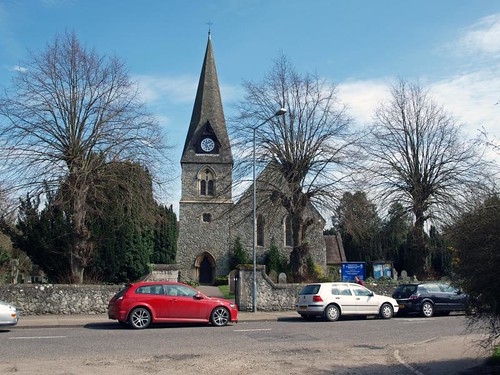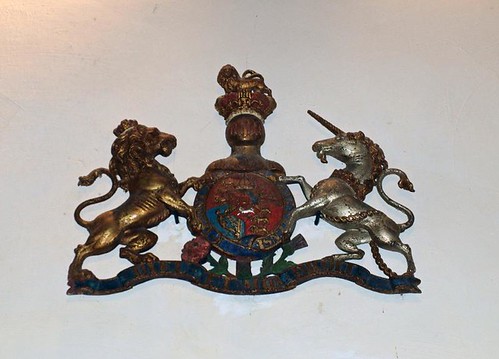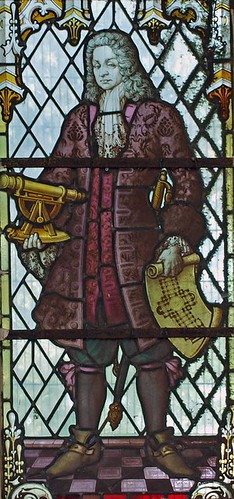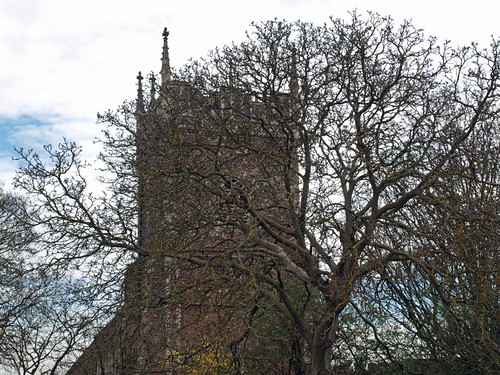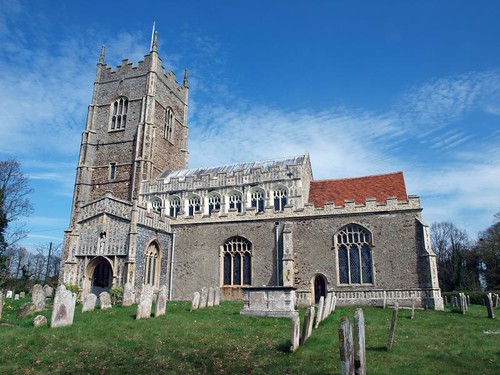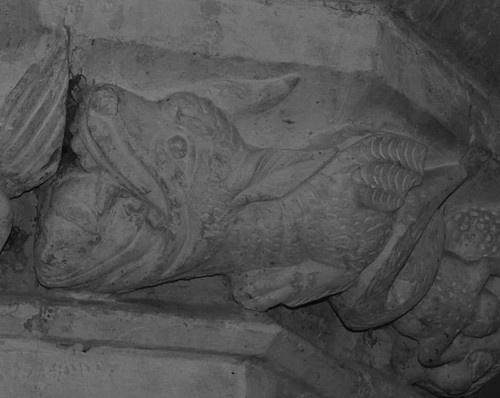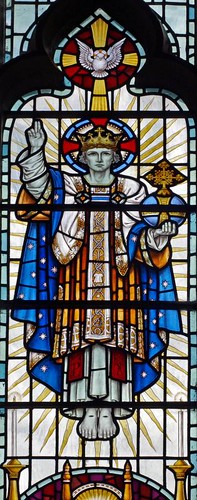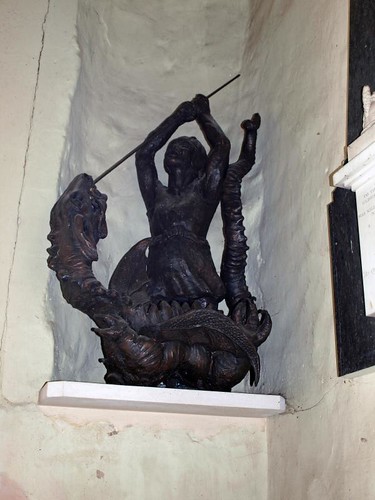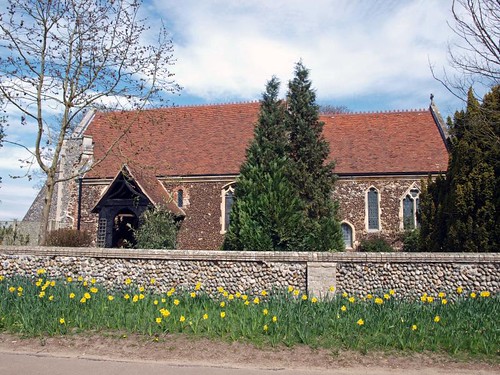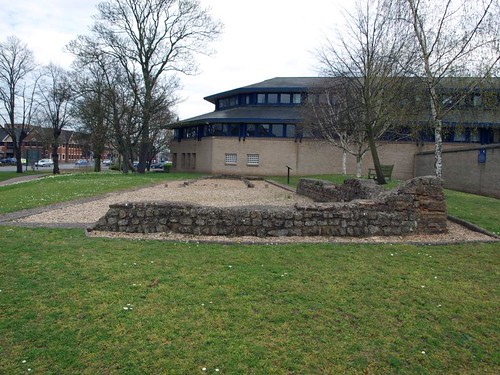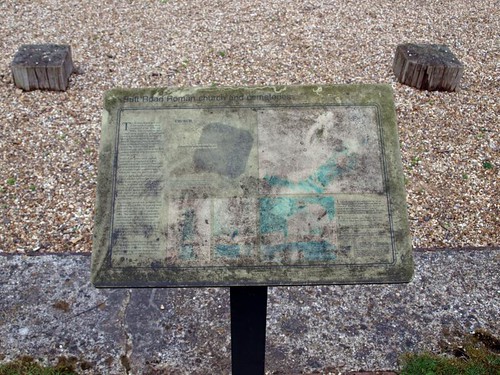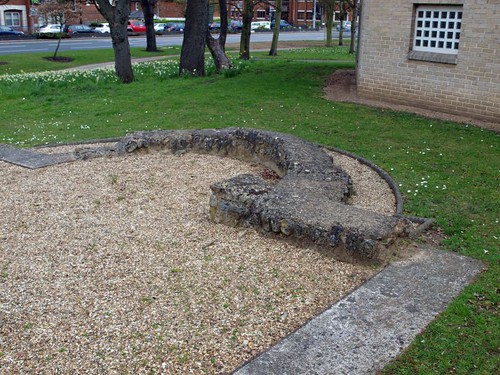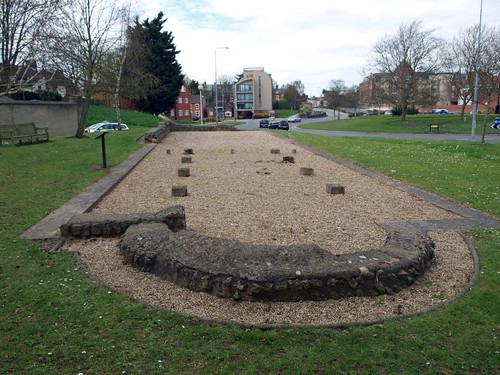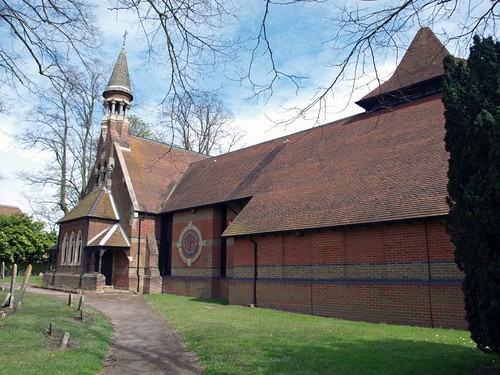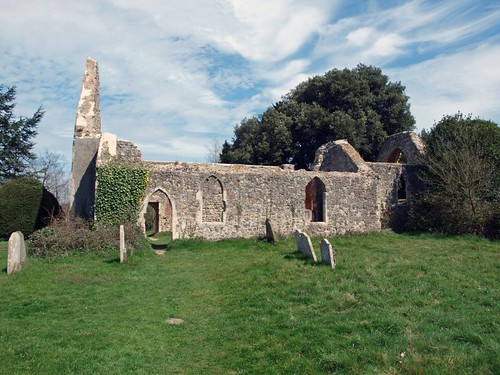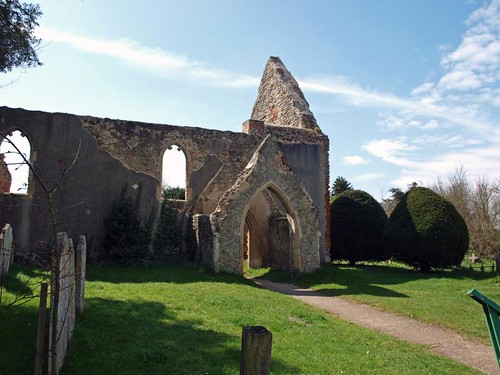Neither Pevsner nor Mee bothered and I can't say I blame them.
Saturday 27 April 2013
Little Bromley
St Mary the Virgin is in the care of the CCT and was open when I
visited. Very restored and rather plain I liked it for its simplicity
and for the fact that it was open.
ST MARY THE VIRGIN. Nave and chancel in one, and W tower. The nave is Norman, see one N and two S windows. The chancel belongs to c. 1300, E window of three lights with intersected tracery, N and S cusped lancet windows. Plain C16 S porch. Of the same time the completion in brick of the C15 W tower. Diagonal buttresses, three-light W window. - FONT. Octagonal, stem with buttresses, bowl with the four Symbols of the Evangelists and four rosettes. The figure carving is very primitive. - COMMUNION RAILS, c. 1700, with twisted balusters. - PLATE. Paten, perhaps Elizabethan.
ST MARY THE VIRGIN. Nave and chancel in one, and W tower. The nave is Norman, see one N and two S windows. The chancel belongs to c. 1300, E window of three lights with intersected tracery, N and S cusped lancet windows. Plain C16 S porch. Of the same time the completion in brick of the C15 W tower. Diagonal buttresses, three-light W window. - FONT. Octagonal, stem with buttresses, bowl with the four Symbols of the Evangelists and four rosettes. The figure carving is very primitive. - COMMUNION RAILS, c. 1700, with twisted balusters. - PLATE. Paten, perhaps Elizabethan.
Another one Mee missed.
Hythe
St Leonard is in the care of the CCT so I was pretty sure it would be
open but found it locked with two keyholders who were both out.
Technically speaking finding it locked was my fault as a sign clearly
stated that it is open on Saturday 11-3 and Tuesday 12-3 and that "at
other times the key may be available", so I was at the right place but
at the wrong time. To be fair it is opened by a voluntary custodian and I
assume the opening times are dictated by his other commitments; also I
don't think it's a particularly interior from what I've seen on the web.
ST LEONARD. Close to the street. Impressive but much restored. The battlements and pinnacles of the C14 W tower (angle buttresses) e.g. are new. The S porch is rebuilt, the (embattled) S aisle has new windows. The N side is more rewarding. N aisle of c. 1330, N chancel chapel of c. 1500. The N arcades show these dates clearly too. The piers of the Dec style are quatrefoil, as usual, the C15 piers are of four shafts and four hollows in the diagonals. The arch mouldings differ too. The C15 type appears in the S arcade, the W bay of the N arcade and both chancel chapels. Modest hammerbeam roof in the nave. - FONT. Octagonal, Perp, with shields in quatrefoils and big leaves. - PLATE. Fine Mazer with gilt rim, 1521; large Elizabethan Cup; large Cup probably of 1624; Paten of 1713.
ST LEONARD. Close to the street. Impressive but much restored. The battlements and pinnacles of the C14 W tower (angle buttresses) e.g. are new. The S porch is rebuilt, the (embattled) S aisle has new windows. The N side is more rewarding. N aisle of c. 1330, N chancel chapel of c. 1500. The N arcades show these dates clearly too. The piers of the Dec style are quatrefoil, as usual, the C15 piers are of four shafts and four hollows in the diagonals. The arch mouldings differ too. The C15 type appears in the S arcade, the W bay of the N arcade and both chancel chapels. Modest hammerbeam roof in the nave. - FONT. Octagonal, Perp, with shields in quatrefoils and big leaves. - PLATE. Fine Mazer with gilt rim, 1521; large Elizabethan Cup; large Cup probably of 1624; Paten of 1713.
St
Leonard’s is at the Hythe, a 14th century church with a beautiful
hammerbeam roof 400 years old, richly moulded, and well lit from the
clerestory. Four angels which once held it up are in the vestry. The
roofs of two chapels are a century older than the nave’s. There are six
old chairs, a mazer bowl of 1521 with a silver rim, and an Elizabethan
cup with two bands of ornament, and two medieval bells still ringing in
the tower, from which a remarkable clock face of stone looks down. It is
as old as 1500 and has carved spandrels. Two heads which once supported
the roof beam still project from the walls at the chancel arch. The
windows are attractive with 24 big figures, among them Thomas Becket,
Helena, Ethelbert, the Confessor, and Charles Stuart. The door by which
we come and go is 500 years old and pierced with holes made by the
bullets of the Parliament men in the Civil War.
Simon K -
One of the survivors was St Leonard. Set on the Hythe, the old
Colchester port area, now a rundown area of 19th century streets and
warehouses, but 'coming up' with apartments along the waterfront. This
was the former parish church, but is now redundant and in the care of
the CCT.
St Leonard is the biggest and grandest church in Colchester, about a mile from the town centre. It would not be out of place in rural Suffolk, with aisles and a clerestory, and its tower surmounted with flushwork and pinnacles. The church is open Tuesdays and Saturdays, with a keyholder notice at other times, but both keyholders were out, which was my big disappointment of the day.
The south door has repaired musket ball holes in it - the Siege of Colchester was broken here when the Royalists guarding the river crossing were overpowered by a regiment of Suffolk parliamentarians who took the church and laid open the way into the centre of the Borough. An extraordinary prospect, looking up Hythe Hill.
Simon K -
Colchester is unusual, and perhaps unique in England, because for a
town of 150,000+ people it has no large central church. There were
nine small medieval parishes, each with its own small church, but none
as big as Ipswich's St Mary le Tower, or Norwich's St Peter Mancroft,
or Cambridge's St Mary the Great. They suffered two depredations that
churches nowhere else in England had to suffer - most were ruined
during the 1648 Seige of Colchester (being the only fortified
buildings in town, the Royalists holed up in them and they were
attacked by the Parliamentarians) and then the earthquake of 1884,
after which two of them were demolished.
St Leonard is the biggest and grandest church in Colchester, about a mile from the town centre. It would not be out of place in rural Suffolk, with aisles and a clerestory, and its tower surmounted with flushwork and pinnacles. The church is open Tuesdays and Saturdays, with a keyholder notice at other times, but both keyholders were out, which was my big disappointment of the day.
The south door has repaired musket ball holes in it - the Siege of Colchester was broken here when the Royalists guarding the river crossing were overpowered by a regiment of Suffolk parliamentarians who took the church and laid open the way into the centre of the Borough. An extraordinary prospect, looking up Hythe Hill.
Greenstead
St Andrew was locked with no keyholder listed. With ugly cement
rendering to the north and east and a spectacularly ugly south aisle
tacked on to the nave I wasn't disappointed.
ST ANDREW. Thin W tower of c. 1600, with two- and three-light arched windows without any arches to the lights or any tracery. The W window is of the C18. Nave and chancel Norman. NW angle with Roman brick. Plain Norman N doorway. The S arcade and whole S aisle C19. - PLATE. Cup of the early C17.
ST ANDREW. Thin W tower of c. 1600, with two- and three-light arched windows without any arches to the lights or any tracery. The W window is of the C18. Nave and chancel Norman. NW angle with Roman brick. Plain Norman N doorway. The S arcade and whole S aisle C19. - PLATE. Cup of the early C17.
Mee missed it.
Simon K -
Locked, no keyholder notice. A church of little interest except that
the red brick tower is entirely 1600, a most unusual date. It would be
interesting to know why they built it. Had the old one fallen? This is
a landmark hilltop site, so was that the reason? The church against it
is now 19th Century.
There was a group of young 'Community Payback' workers clearing and tidying up the churchyard, and you would not have needed to be a maiden aunt to have blushed at the things they were shouting at each other, but they were very civil to me and I took advantage of the fact they had access to the kitchen area in the south aisle to photograph the one treasure the roundel royal arms to George I. This was through the glass of the locked inner door, I'm afraid. And then I at last broke free of Colchester's urban sprawl, because between me and the next church was Wivenhoe Park, campus home of the University of Essex, and beyond it Wivenhoe.
Simon K -
A few hundred yards above Hythe railway station in the suburbs of
Colchester sits this odd little church.
There was a group of young 'Community Payback' workers clearing and tidying up the churchyard, and you would not have needed to be a maiden aunt to have blushed at the things they were shouting at each other, but they were very civil to me and I took advantage of the fact they had access to the kitchen area in the south aisle to photograph the one treasure the roundel royal arms to George I. This was through the glass of the locked inner door, I'm afraid. And then I at last broke free of Colchester's urban sprawl, because between me and the next church was Wivenhoe Park, campus home of the University of Essex, and beyond it Wivenhoe.
Great Bromley
When I first saw St George I thought I'd made a wrong turn and ended
up in mid Suffolk for this is, as Pevsner puts it, "entirely in the East
Anglian style", so much so that it out Suffolks some Suffolk churches.
This is, without doubt, one of the top ten Essex churches and as such is
must see.
My only quibble is that the brass is now inaccessible having been carpeted over - nevertheless wow!
ST GEORGE. A fine sight, proud and compact; entirely in the East Anglian style. Big W tower, tall nave with tall clerestory of closely set windows, short chancel. The W tower is the most spectacular piece. It starts at the base with a quatrefoil frieze, The buttresses are clasping but continue higher up as a combination of diagonal and angle buttresses. W doorway with fleurons in the jambs and voussoirs, hood-mould on an eagle and an angel. Five-light W window with panel tracery, three-light bell-openings with one transome. Stepped battlements and crocketed pinnacles. The S porch is all flushwork-panelled. It has a parapet instead of the more usual battlements. Niche above the doorway, three-light side openings. The S doorway has fleurons in one order and a foliage trail in the other, both in jambs and voussoirs. Above two re-set spandrel figures: Adam and Eve. The S chapel is also singled out as something special - by flushwork panelling at the base. Three-light windows in the aisles, with Perp panel tracery, the patterns different on the S and N sides.* Two-light windows with one transome in the chancel (the E window is C19). The clerestory windows of two-lights are oddly not in line with the arcades below. There are seven windows to three bays. The S arcade is C14, the N arcade C15. Both have octagonal piers, but the proportions differ characteristically. The S piers have capitals generously decorated with leaves. The westernmost instead uses fifigures of angels, lions, a head with tongue out and a dragon and a frog biting him. The nave is covered by one of the most magnificent roofs of Essex, a double-hammerbeam (cf. Castle Hedingham, Gestingthorpe). - S and N DOORS. Both elaborately traceried; c. 1500. - BRASS. William Bischopton d. 1432, figure of a priest, about 3 ft long, under an arch and a gable with concave sides, crocketed and originally pinnacled.
* N doorway minor, yet with three orders of fleurons in jambs and voussoirs.
My only quibble is that the brass is now inaccessible having been carpeted over - nevertheless wow!
ST GEORGE. A fine sight, proud and compact; entirely in the East Anglian style. Big W tower, tall nave with tall clerestory of closely set windows, short chancel. The W tower is the most spectacular piece. It starts at the base with a quatrefoil frieze, The buttresses are clasping but continue higher up as a combination of diagonal and angle buttresses. W doorway with fleurons in the jambs and voussoirs, hood-mould on an eagle and an angel. Five-light W window with panel tracery, three-light bell-openings with one transome. Stepped battlements and crocketed pinnacles. The S porch is all flushwork-panelled. It has a parapet instead of the more usual battlements. Niche above the doorway, three-light side openings. The S doorway has fleurons in one order and a foliage trail in the other, both in jambs and voussoirs. Above two re-set spandrel figures: Adam and Eve. The S chapel is also singled out as something special - by flushwork panelling at the base. Three-light windows in the aisles, with Perp panel tracery, the patterns different on the S and N sides.* Two-light windows with one transome in the chancel (the E window is C19). The clerestory windows of two-lights are oddly not in line with the arcades below. There are seven windows to three bays. The S arcade is C14, the N arcade C15. Both have octagonal piers, but the proportions differ characteristically. The S piers have capitals generously decorated with leaves. The westernmost instead uses fifigures of angels, lions, a head with tongue out and a dragon and a frog biting him. The nave is covered by one of the most magnificent roofs of Essex, a double-hammerbeam (cf. Castle Hedingham, Gestingthorpe). - S and N DOORS. Both elaborately traceried; c. 1500. - BRASS. William Bischopton d. 1432, figure of a priest, about 3 ft long, under an arch and a gable with concave sides, crocketed and originally pinnacled.
* N doorway minor, yet with three orders of fleurons in jambs and voussoirs.
GREAT
BROMLEY. A pleasant little place in the valley of the Frating Brook, it
has a splendid church showing how wonderfully well the medieval workers
in wood and stone could add beauty to the work of earlier days. The
church is 15th century. The glorious tower with its pinnacles and great
buttresses, and the clerestory with 14 great windows over 14th century
arcades, were built in 1500. The high-pitched double-hammer roof with
its richly moulded beams and curved braces belongs to the same period.
The wall-posts of this lovely roof terminate in canopied niches in which
saints stand on stone corbels carved with angels. The capitals of the
piers in the nave are carved with oak leaves and grotesque beasts, one
swallowing a man and one attacking a woman. There were many brasses on
the stones in the floor but only two remain, one of William Bischopton,
who died in 1432, and the other of John Hubbard, buried in 1537.
Here in our own century has been placed a window by American descendants of Gregory and Simon Stone, who left Great Bromley in 1634 to settle in the new land then growing up to be a New World. The window has a delightful picture of the ship which bore these courageous emigrants across the broad Atlantic, and in its scene is a stately figure of a Red Indian.
Perhaps best of all is the porch through which we come to see all this. It has a lovely doorway and a charming parapet, with big windows and walls of knapped flints in elaborately traceried stone panels; and it is a masterpiece of 15th century building.
Here in our own century has been placed a window by American descendants of Gregory and Simon Stone, who left Great Bromley in 1634 to settle in the new land then growing up to be a New World. The window has a delightful picture of the ship which bore these courageous emigrants across the broad Atlantic, and in its scene is a stately figure of a Red Indian.
Perhaps best of all is the porch through which we come to see all this. It has a lovely doorway and a charming parapet, with big windows and walls of knapped flints in elaborately traceried stone panels; and it is a masterpiece of 15th century building.
Frating
Dedication unknown, Frating church is redundant and has been converted into a house. It lost its tower sometime in the 90s perhaps when it was converted.
CHURCH (Dedication unknown). Nave, chancel and W tower. The nave has a Norman window with Roman brick surround on the S side, and a Dec window which is repeated similarly on the N side. The chancel windows are of c. 1300. Plain timber S porch. W tower with thin diagonal buttresses, a three-light W window, and tall brick and flint panelling in the battlements. Pyramid roof. Inside, an early C16 recess in the chancel. The depressed pointed arch is adorned with fleurons, the spandrels with big leaves. - PLATE. Cup of 1584.
Flickr.
CHURCH (Dedication unknown). Nave, chancel and W tower. The nave has a Norman window with Roman brick surround on the S side, and a Dec window which is repeated similarly on the N side. The chancel windows are of c. 1300. Plain timber S porch. W tower with thin diagonal buttresses, a three-light W window, and tall brick and flint panelling in the battlements. Pyramid roof. Inside, an early C16 recess in the chancel. The depressed pointed arch is adorned with fleurons, the spandrels with big leaves. - PLATE. Cup of 1584.
FRATING. In good farming country, with cottages widely scattered, it has a small stone church with an embattled tower and a red and blue tiled spire. But in this tower are thin red tiles from Roman villas which stood here, some of them encircling a little Norman window peeping at us over the tiled roof of the 600-year-old porch. In the tower is a bell which was ringing at the time of Agincourt, and another which would ring with it at the coming of the Tudor dynasty. There is an Easter Sepulchre 400 years old, and the altar tomb in alabaster and black marble of Thomas Bendish, who died in the same year as Queen Elizabeth.
Colchester - Roman Chapel
In the mid to late 1970's a new police station was built in Butts
Road and Colchester's oldest church and cemetery, and purportedly
Britain's, was discovered. Dating back to AD 320-40 over 700 graves were
uncovered, most of which dated back to the 4th century (others were
from earlier pagan burials overlaid in later times), and consisted of a
mix of wooden and lead coffins, hollowed tree trunks and various other
materials.
It had an apsidal chancel and wooden N & S arcades which are shown by oak blocks on the site whilst concrete strips replace the missing foundations.
It is situated on a busy roundabout by a hideous police station, very little remains and it seems to be neglected - the information table was almost illegible - but this is still an extraordinary place outdating Essex's previously oldest church, St Andrew, Greensted, by 600 years; it's oddly atmospheric.
Whilst reading up on the Roman Chapel I found this site which catologues architectural atrocities in Colchester - it's not been updated since before Christmas and even though I'm not a resident of Colchester I do hope it keeps going.
Obviously neither Pevsner nor Mee covered Butts Road as it hadn't been excavated.
It had an apsidal chancel and wooden N & S arcades which are shown by oak blocks on the site whilst concrete strips replace the missing foundations.
It is situated on a busy roundabout by a hideous police station, very little remains and it seems to be neglected - the information table was almost illegible - but this is still an extraordinary place outdating Essex's previously oldest church, St Andrew, Greensted, by 600 years; it's oddly atmospheric.
Whilst reading up on the Roman Chapel I found this site which catologues architectural atrocities in Colchester - it's not been updated since before Christmas and even though I'm not a resident of Colchester I do hope it keeps going.
Obviously neither Pevsner nor Mee covered Butts Road as it hadn't been excavated.
Colchester - St John
I include St John for the same reason people climb Everest.
ST JOHN, Ipswich Road. 1864 by Arthur Blomfield (GR) and still with the grit which he possessed in his youth. Red brick with yellow and blue bricks and stone dressings. Nave and chancel. Small and low W baptistery with timber porches l. and r., and the weirdest (and most tasteless) way to connect this with a bellcote which is circular, with a conical roof and a kind of open lantern with thick short black columns.
ST JOHN, Ipswich Road. 1864 by Arthur Blomfield (GR) and still with the grit which he possessed in his youth. Red brick with yellow and blue bricks and stone dressings. Nave and chancel. Small and low W baptistery with timber porches l. and r., and the weirdest (and most tasteless) way to connect this with a bellcote which is circular, with a conical roof and a kind of open lantern with thick short black columns.
Friday 26 April 2013
Alresford
A week ago today I went on an ambitious trip intending to visit 13
churches (most of which I assumed would be locked) in and around
Colchester; when I arrived at my first stop, Little Bromley, I
discovered that my battery was in its charger at home - so on Wednesday I
tried again.
St Peter is a ruin and rather a nice one. Following a major fire in 1971 it was abandoned but having been Grade II listed in 1966 it is now in the care of Essex County Council. A quick Google reveals all sorts of nonsense about it being used for witchcraft rituals and apparently it's a huge draw for those interested in the paranormal - all bollocks of course but here's a hilarious investigation.
I think it's actually more attractive now than when it was extant although it's a shame to have lost Mee's Morris chancel window.
CHURCH. Nave, lower (rebuilt) chancel, and (rebuilt) belfry Roman brick quoins at the W end date the nave as Norman. Nice W gallery with twisted balusters, C18.
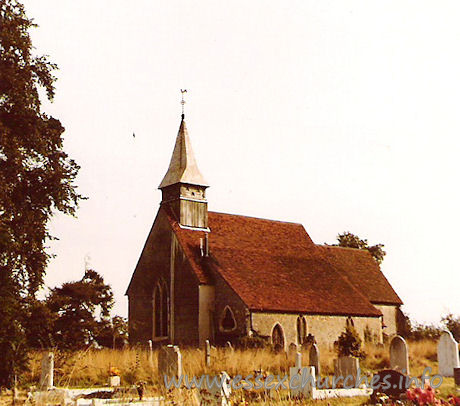
ALRESFORD. A scattered little place on high tableland, nature has endowed it with fine woods round Alresford Hall, and round the old farmhouse called Tenpenny Brook, which has timbers that have lasted 400 years. A little way off (a mile to the west) a few fragments of brick and tessellated paving mark the site of a Roman house; we have seen Samian ware and painted plaster from it in Colchester Museum. A long lane leads us to the little church standing with a cross to village heroes in the loneliness of the fields. The shingled spire of the belfry rises above the walls the Normans built, and there are Roman tiles set in the corners of the nave. Over the altar is a lovely William Morris window.
Flickr.
Simon K.
This is still the parish burial ground, and you have to walk through
the church from north porch to south porch to get to the modern
graves, which is a nice touch. Rather a sad place, for all that.
Alresford, pronounced Arls-f'd, is a big village, and you can't help thinking it must have lost a sense of its identity when it lost its church. But it still has its railway station, so I took the train back into Colchester and then home to Ipswich.
St Peter is a ruin and rather a nice one. Following a major fire in 1971 it was abandoned but having been Grade II listed in 1966 it is now in the care of Essex County Council. A quick Google reveals all sorts of nonsense about it being used for witchcraft rituals and apparently it's a huge draw for those interested in the paranormal - all bollocks of course but here's a hilarious investigation.
I think it's actually more attractive now than when it was extant although it's a shame to have lost Mee's Morris chancel window.
CHURCH. Nave, lower (rebuilt) chancel, and (rebuilt) belfry Roman brick quoins at the W end date the nave as Norman. Nice W gallery with twisted balusters, C18.

ALRESFORD. A scattered little place on high tableland, nature has endowed it with fine woods round Alresford Hall, and round the old farmhouse called Tenpenny Brook, which has timbers that have lasted 400 years. A little way off (a mile to the west) a few fragments of brick and tessellated paving mark the site of a Roman house; we have seen Samian ware and painted plaster from it in Colchester Museum. A long lane leads us to the little church standing with a cross to village heroes in the loneliness of the fields. The shingled spire of the belfry rises above the walls the Normans built, and there are Roman tiles set in the corners of the nave. Over the altar is a lovely William Morris window.
Flickr.
Simon K.
This small Norman church was destroyed by fire in 1972, and they took
the opportunity to build a new one half a mile off in the centre of
the village. There's no doubt that twenty years later it would have
been restored, but it is a good ruin, all exterior walls surviving in
flint, ragstone and red brick, the window openings filling the ruin
with light.
Alresford, pronounced Arls-f'd, is a big village, and you can't help thinking it must have lost a sense of its identity when it lost its church. But it still has its railway station, so I took the train back into Colchester and then home to Ipswich.
Subscribe to:
Posts (Atom)
